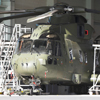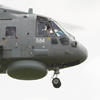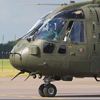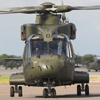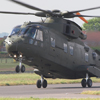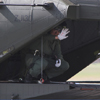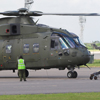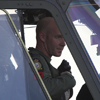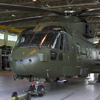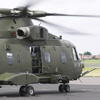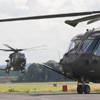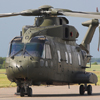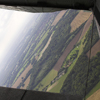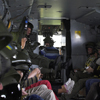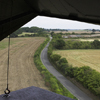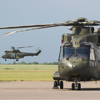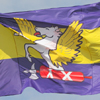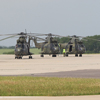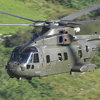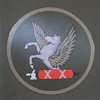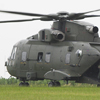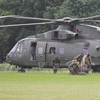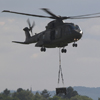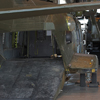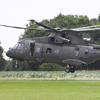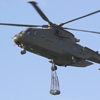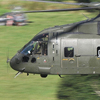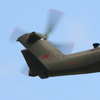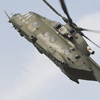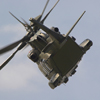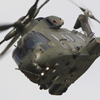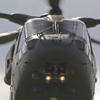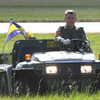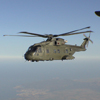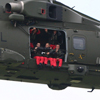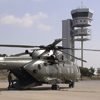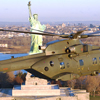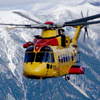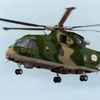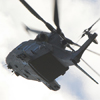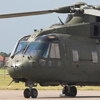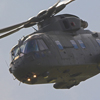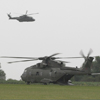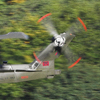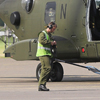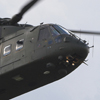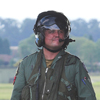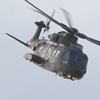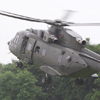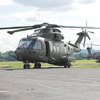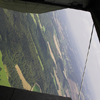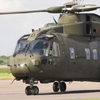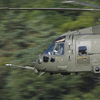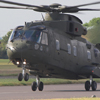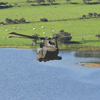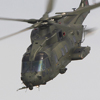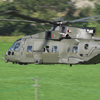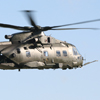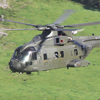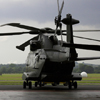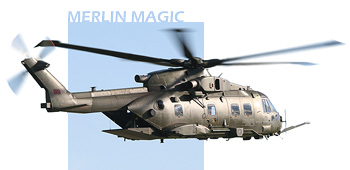
RAF Merlin HC Mk.3 Feature Report
September
The Agusta-Westland EH101 may have had a rather colourful and prolonged development, but the order book now steadily continues to grow, with overseas orders having been received from the Canadian Navy, the Royal Danish Air Force, the Portugeuse Air Force, Japan's Maritime Self Defence Force, and most notably the recent US Navy order to supply 23 US101 aircraft to fulfill the US Presidential Transport role. So how are the Royal Air Force getting on with one of their newest additions to the inventory?
looks back at the development of the Merlin, and has been fortunate enough to catch up with 28(AC) Sqn doing what they do best.
The Merlin, as we now know it, was originally conceived in 1980, as discussions took place between Westland and Italian helicopter manufacturer, Agusta, who had both been set the task by their respective governments of finding a replacement for the Sea King in the antisubmarine warfare (ASW) role, a few years earlier. Those discussions ultimately lead to the creation of European Helicopter (EH) Industries, who would be responsible for the development of the new helicopter, designated the EH101.
As discussions and design studies progressed, a number of other viable variants were tabled; the basic naval version, the naval utility version, the "Heliliner", an army transportation version and a civilian utility variant, and in 1984 the British and Italian governments signed an agreement, which provided joint funding for the development, right through to the production stage. This programme was to be a joint work share undertaken by both Westland and Agusta.
The first potential stumbling block for the project came along in 1986 when Westland were virtually forced to declare themselves bankrupt. A rescue package was put together by the Stratford-based arm of United Technologies Corporation, namely Sikorsky. It saw the American company acquire a 14.9% interest in Westland. This was by no means the first dealings between the two companies. For four decades Sikorsky had sent Westland sensitive technology and had even issued them with licenses to build hundreds of Sikorsky's own aircraft, but what Westland gained from this investment went much deeper than the direct financial gains. The perilous position Westland found themselves in is said to have nearly cost the then Prime Minister, Margaret Thatcher, her job. The irony of this part of the story would not become apparent until almost two decades later.
It was the 9th of October 1987 before the first prototype, "PP1", flew in Britain. The subsequent flight testing programme encountered a multitude of problems. The first Italian built aircraft, "PP2" - a basic development aircraft, sadly suffered a crash in early 1993 which led to the grounding of all EH101 prototypes for a period of five months. The incident was found to have been caused by a rotor brake malfunction. "PP4" - another basic development aircraft, was lost in a crash caused by a control rod failure in 1994, while "PP7" (used for the development of the rear-loading ramp and it's associated systems, which were to be seen on the utility version) was also involved in an incident.
Aside from the obvious implication of these accidents, EH Industries also encountered many problems in developing the advanced avionics systems that were to be encorporated into the ASW variant of the aircraft. These issues, combined with the end of the Cold War and subsequent re-evaluation of the defence requirements of the major players, inevitably added significant time to the development process for the EH101, but by 1991 the company felt they were at a stage where they were ready to take initial production orders.
On the 9th of October of that year, the Royal Navy placed an order for a total of 44 ASW variants, to be known as the Merlin HM Mk.1. Then on the 9th of March 1995 a further Ministry of Defence order was received, this time for 22 of the utility variants, designated Merlin HC Mk.3, and ordered on behalf of the Royal Air Force. The Italian Navy formally ordered 16 EH101s in August 1997.
EH Industries name was replaced by "Agusta-Westland" in July 2000, following a full merger, and from this point on the aircraft was to be known as the "Agusta-Westland EH101".
The 27th of October 2000 witnessed the loss of the first production aircraft, when a RN Merlin HM Mk.1 came to grief. Again, the rotor brake was deemed to have malfunctioned and caused the crash, which resulted in the immediate grounding of all UK Merlins. This grounding was lifted on the 19th of December of the same year.
Eight days earlier, on December 11th, the Merlin HC Mk.3 finally entered service with the Royal Air Force in it's designated role of "combat transport". It is powered by three, Rolls-Royce Turbomeca RTM322 turboshaft engines, has an all up weight capacity of 15,600kg and can lift under-slung-loads (USLs) up to 4,500kg (albeit not very far at that weight!). Able to accommodate up to 24 fully-kitted troops, 16 stretchers, or other loads of similar size. The fully functioning hoist also affords the aircraft with a limited search and rescue (SAR) capability. This is a seriously beefy, yet surprisingly agile machine.
The HC Mk.3 has a 'glass cockpit' encorporating digital screens including moving map and forward looking infra-red (FLIR). Each 'cab' is kitted out with a comprehensive defensive aids suite (DAS), comprising directional infra-red countermeasures (DIRCM), laser warning system (LWS), missile approach warning system (MAWS), radar warning receiver (RWR), in addition to six times chaff and flare dispensers - this figure rising to fourteen shortly. There are two side mounting points for general purpose machine guns (GPMG), while aircraft assigned to 1419 Flt have a further ramp mounted GPMG.
It was the 17th of July 2001 when No. 28(AC) Sqn reformed at RAF Benson, Oxon, bringing to an end a four year absence from the RAF inventory. This reformation saw the squadron return to the UK for the first time since 1920. In the interim they had operated from a number of bases in India and Burma, before taking up residence for no less than 48 years in the then British dependency of Hong Kong, their time being divided between Kai Tak and Sek Kong. They currently share the Oxfordshire station with the Pumas of 33 Sqn.
Following the loss of a Royal Navy Merlin HM Mk.1, the fleet were grounded from April 2004 through to the July of the same year. The problem was found to lay with the tail rotor, the issue subsequently rectified and the compliment returned to full operational service.
In it's current format, 28(AC) Sqn is the largest in the whole of the RAF - comprising no less than 22 aircraft (that figure includes a small number of airframes on permanent loan to Boscombe Down and Westland) and 340 aircrew and ground support staff - made up of eight flights. A, B and C are the operational flights, with C's cadre skill being future joint personnel recovery (JPR) in the Combat Search and Rescue (CSAR) role. D Flight is the Operational Conversion Flight (OCF) and E Flight are responsible for the RAF Regiment element. There is also a HQ flight and an Engineering flight.
The squadron is also currently responsible for maintaining a six-aircraft presence in Basrah, Iraq, where they operate under the banner of 1419 Flight as part of the ongoing 'Operation Telic' effort. 1419 Flight provides Multi National Division (MND) (SE) and Joint Helicopter Force (I) with Merlin HC Mk.3s available for tasking at thirty minutes and sixty minutes notice for operations by day and by night, 24 hours per day, 365 days a year. The primary roles for 1419 Flight are assault, fire support, troop moves, airborne command post, reconnaissance and surveillance, convoy protection, forward refuel and Casevac. A recent operation in support of Iraqi Security Forces saw a Battle Group Commander and his Staff using one of the Merlins as an Airborne, Battle Group Command Post running an operation involving several hundred troops, over 40 vehicles, two assault Merlins and other surveillance aircraft.
When an aircraft swap is performed, the replacements are flown out to the region under their own power. When you consider it takes two days to strip an airframe down for loading on to a special cradle that then rolls onto a C17 Globemaster III, a day to fly it out there and a further day to reassemble it, not to mention the extra pressure imposed upon the RAF's already overly stretched transport fleet, you can fully appreciate why. The Merlin HC Mk.3 is perfectly capable of self positioning. Recently a 2000kg internal ‘bolt-down’ fuel tank was trialled on an aircraft bound for the region, and the aircraft and crew in question successfully flew 3500 miles in just three days. This aircraft change now takes place every three months, but normally without the use of the internal tank.
The Iraqi conflict, however, does not represent the Merlin HC Mk.3’s first experience of frontline combat. Back in 2003 they saw service in Bosnia under Operation Oculus.
As part of Joint Helicopter Command (JHC), 28(AC) Sqn is regularly tasked to support the UK Armed Forces in a variety of roles. The main function of the Merlin is to provide battlefield support to the British Army. This can involve the movement of troops around the battlefield area and the logistical re-supply of equipment, either internally or as underslung loads. A typical example would be to move a battery of 105mm Light Guns from one firing position to another in as quick a time as possible.
With the recent development of 16 Air Assault Brigade, '28' have been heavily involved in rapid deployment exercises, such as Eagles Strike that took place earlier this year in the South West. A large percentage of the UK Support Helicopter (SH) assets were involved, including the first deployment of the AAC's new AH64 Apache, and this demonstrated perfectly the tri-service helicopter capability that JHC has to offer.
In addition to their operational commitments, the squadron also provide the highly acclaimed 2005 Merlin Display Team, lead by Sqn Ldr Mark Beardmore, who first displayed the aircraft back in 2002. Mark has more than 6000 hours to his name on helicopters, including in excess of 4000 on the Chinook and he now has over 1500 hours 'on type' in the book. In 1986 he had the distinction of being the Chinook display pilot and in 1991 he saw front-line action, flying them in operations during Desert Storm. He's currently a Qualified Helicopter Instructor (QHI) with the OCF.
This is what Mark had to say about the 2005 Merlin Display, and displaying the aircraft in general. "Being of the latest generation of 'in service' helicopter, the Merlin has superior Rotor speed (Nr) and engine control. You can make very rapid and very large power demands on the rotor system and get very little Nr change. On this years display I am typically changing from 20% torque to 110% over a three second band! and while the system is working hard it copes very well and as a comparison to other aircraft I have displayed it is in a different league. When you flare any rotor head the Nr rises. However, with so much inertia in the five blade head the Nr control is easily managed. You notice on the display the ac is rolled and pitched rapidly and this is only really possible due the feedback through the controls and confidence the aircraft gives me when flying it."
Mark continues, "The Merlin display in '02 was the very first year the then 'new' Merlin and me, the then 'new' Merlin pilot (150 hours on type) was demonstrated. Naturally, I took it easy and flew well within the aircraft's and my own capabilities. This year with well over 1000 hours on the aircraft and the RAF (and my) confidence in the aircraft well established, I was in a position to put the aircraft through its paces and fly it right to the limit of the RAF 'release to service'. We have had a fantastic positive response from the public and the normal quote we get it something like: "Isn't it big, much bigger than I thought" and "I didn't think you could throw a helicopter that big around so much in such a small space" and "The Chinooks successor has arrived!".
Crewman and team member, Flt Sgt Gareth Attridge explained how flying the display differs from day-to-day flying from his perspective, in the cabin, "The biggest difference is that your fate is totally in the hands of the Captain. On normal ops the guys up front generally will consult the crewmen before any major decisions are made. As a rule they won’t take off or land unless we give them a safety clearance first. When we’re flying the display you just have to hand that all over to them and it all comes down to trust and having faith in each others ability. It’s a very strange experience for the first few times you do it!"
The highlight of the season for the team so far, was being adjudged to be the "best in show" at the Sanicole airshow, in Belgium, for which they received a piece of modern art by way of recognition. The award itself was presented to the team on-behalf of Belgian Prime Minister, Guy Verhofstadt.
It doesn't seem to matter who you talk to on 28(AC) Sqn, they all speak of the Merlin HC Mk.3 with the same tremendous passion and affection. Master Crewman Paul Couchman, also a member of the team, summed the aircraft up in three words; "Quieter, faster, further". He went on to elaborate, "It's the whole package, the technology, the safety of redundancy and the sheer size and ability compared to any other helicopter I've flown in sets it apart. It is quite simply magic."
Even the engineers are very fond of them. The aircraft utilises a Health and Usage Monitoring System (HUMS) and that combined with the built-in test equipment, has lead to an increased ease of maintenance and resulted in much reduced maintenance hours per flying hours. Flt Lt Rich Stinson told me how reliable they are, "The aircraft just loves to fly. Problems are extremely few and far between."
Consequently, the orderbook continues to grow with much overseas interest. Canada, Denmark, Portugal, Japan and most notably the United States Navy have all placed firm orders, some of which have already been satisfied. It is the order from the US Navy which is by far the most interesting. The requirement is to supply 23 US101s (to be officially designated VH-71) , the name given to the Lockheed-Martin lead team project, to fill the "Marine One" Presidential transportation role, in a deal worth $6.5bn. The ironic part is that the US101's main competitor in the selection process was Sikorsky's own S-92. Yes, the company that had rescued Westland in 1986 and had shared countless technological breakthroughs with, found itself beaten by a company and project it had itself helped to nurture.

